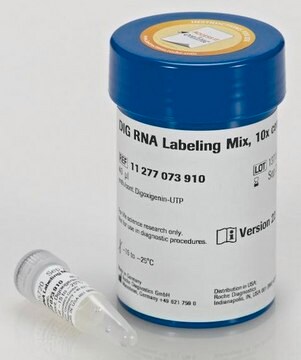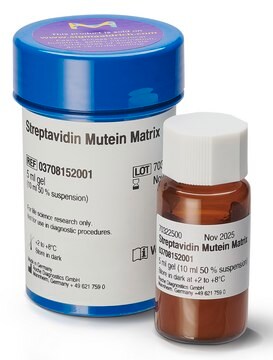11685597910
Roche
Biotin RNA Labeling Mix
sufficient for 20 reactions (transcription), pkg of 40 μL, solution
Sinônimo(s):
Biotin
Faça loginpara ver os preços organizacionais e de contrato
About This Item
Código UNSPSC:
41105500
Produtos recomendados
Formulário
solution
Nível de qualidade
uso
sufficient for 20 reactions (transcription)
embalagem
pkg of 40 μL
fabricante/nome comercial
Roche
Impurezas
Ribonuclease, none detected
cor
colorless
solubilidade
water: miscible
temperatura de armazenamento
−20°C
Descrição geral
Convenient nucleotide mixture for the labeling of RNA with Biotin-16-UTP.
Especificidade
Heat inactivation: Stop the reaction by adding 2 μl 0.2 M EDTA (pH 8.0).
Aplicação
Biotin RNA Labeling Mix has been used for RNA labeling with Biotin-16-UTP by in vitro transcription with SP6, T7, and T3 RNA polymerases.
Biotin-labeled RNA is also used in a variety of hybridization techniques:
Biotin-labeled RNA is also used in a variety of hybridization techniques:
- Southern blots
- Northern blots
- Dot blots
- Plaque or colony lifts
- RNase protection experiments
- In situ hybridizations
- Microarray hybridizations
- RNA pull down assay
Características e benefícios
Contents
10x concentrated solution with: 10mM each ATP, CTP, GTP, 6.5mM UTP, 3.5mM Biotin-16-UTP, pH 7.5
10x concentrated solution with: 10mM each ATP, CTP, GTP, 6.5mM UTP, 3.5mM Biotin-16-UTP, pH 7.5
Qualidade
Function tested in combination with the DIG RNA Labeling Kit.
Princípio
Biotin-labeled, single-stranded RNA probes of defined length are generated by in vitro transcription. Biotin-16-UTP is incorporated by SP6, T7, and T3 RNA polymerases at approximately every 20 to 25th nucleotide of the transcript under the conditions described below. The Biotin RNA Labeling Mix is specifically designed for the use with Roche SP6,T7, and T3 RNA Polymerases, which are supplied with an optimized transcription buffer.
Nota de preparo
Assay Time: 135 minutes
Sample Materials
Sample Materials
- Linearized plasmid DNA: The DNA to be transcribed is cloned into the polylinker site of an appropriate transcription vector which contains adjacent to the polylinker a promoter for SP6, T7 or T3 RNA polymerase. For the synthesis of ′run off′ transcripts the plasmid is linearized by a restriction enzyme. Restriction enzymes creating 5′-overhangs should be used; 3′ overhangs should be avoided. The linearized template DNA should be purified by phenolchloroform extraction and ethanol precipitation, to avoid RNase contamination. For ′run around′ transcription circular plasmid DNA is used.
- PCR product: PCR-fragments which contain RNA polymerase promoter sequences can also act as templates for transcription. Purification of the correct PCR fragment by gel electrophoresis prior to transcription is recommended.
- Labeling Efficiency :A standard labeling reaction with 1μg linear template DNA and an RNA polymerase produces approx. 10μg of full-length, biotin-labeled RNA. In a spot test, a combination of anti-biotin-AP and the chemiluminescence substrate CSPD can detect as little as 0.3pg of the biotin-labeled RNA.
Outras notas
For life science research only. Not for use in diagnostic procedures.
Classe de risco de água (WGK)
WGK 1
Ponto de fulgor (°F)
does not flash
Ponto de fulgor (°C)
does not flash
Escolha uma das versões mais recentes:
Já possui este produto?
Encontre a documentação dos produtos que você adquiriu recentemente na biblioteca de documentos.
Os clientes também visualizaram
Oskar Marín-Béjar et al.
Methods in molecular biology (Clifton, N.J.), 1206, 87-95 (2014-09-23)
Recent advances in genomics have revealed that cells encode thousands of noncoding RNA molecules that do not require translation to proteins to perform their biological roles. Although very little is known about the mechanisms of function of noncoding RNAs, these
Andrea Bleckmann et al.
Methods (San Diego, Calif.), 98, 66-73 (2015-11-03)
First evidence on gene function and regulation is provided by the cellular expression pattern in complex tissues. However, to understand the activity of a specific gene, it is essential to analyze the regulatory network, which controls the spatio-temporal translation pattern
Fei Wang et al.
Cell death and differentiation, 28(9), 2634-2650 (2021-03-26)
The brain is known to express many long noncoding RNAs (lncRNAs); however, whether and how these lncRNAs function in modulating synaptic stability remains unclear. Here, we report a cerebellum highly expressed lncRNA, Synage, regulating synaptic stability via at least two
Henrik Lindehell et al.
Chromosoma, 124(3), 385-395 (2015-02-20)
In Drosophila, the male-specific lethal (MSL) complex specifically targets the male X chromosome and participates in a twofold increase in expression output leading to functional dosage compensation. The complex includes five proteins and two non-coding RNAs (ncRNAs). A number of
Bing Chen et al.
Scientific reports, 6, 23330-23330 (2016-03-22)
An increasing number of long noncoding RNAs (lncRNAs) have been discovered with the recent advances in RNA-sequencing technologies. lncRNAs play key roles across diverse biological processes, and are involved in developmental regulation. However, knowledge about how the genome-wide expression of
Nossa equipe de cientistas tem experiência em todas as áreas de pesquisa, incluindo Life Sciences, ciência de materiais, síntese química, cromatografia, química analítica e muitas outras.
Entre em contato com a assistência técnica





